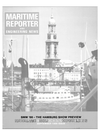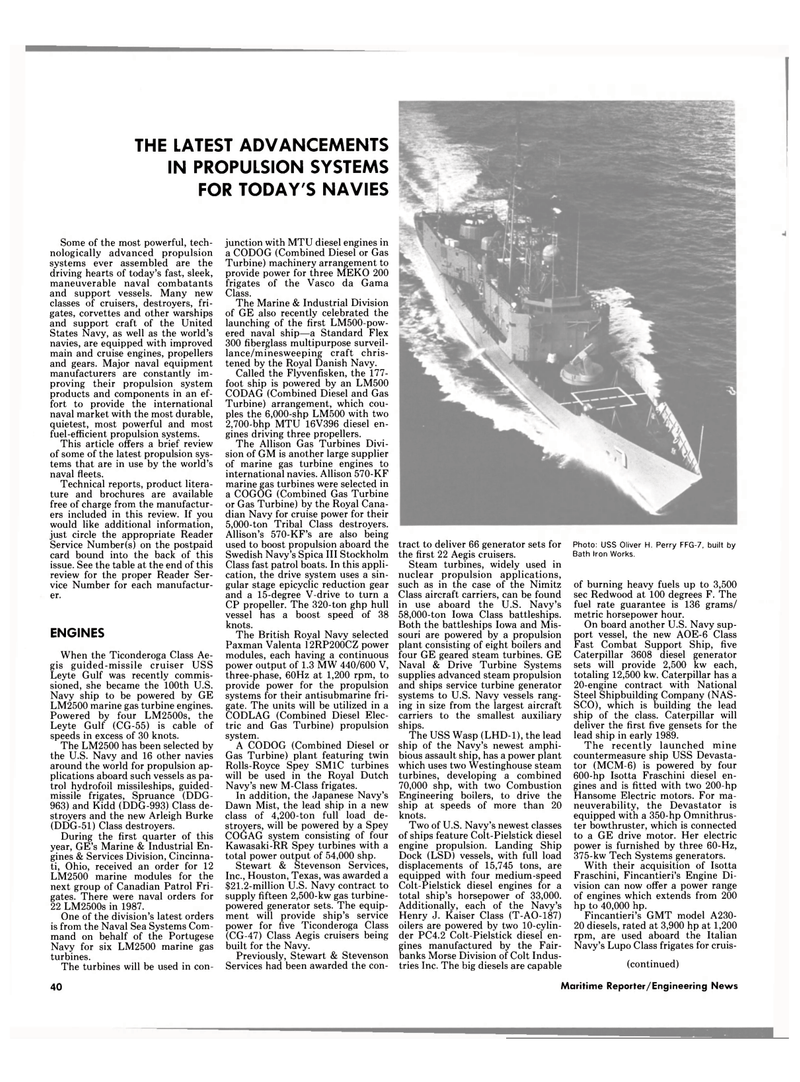
Page 34: of Maritime Reporter Magazine (September 1988)
Read this page in Pdf, Flash or Html5 edition of September 1988 Maritime Reporter Magazine
THE LATEST ADVANCEMENTS
IN PROPULSION SYSTEMS
FOR TODAY'S NAVIES
Some of the most powerful, tech- nologically advanced propulsion systems ever assembled are the driving hearts of today's fast, sleek, maneuverable naval combatants and support vessels. Many new classes of cruisers, destroyers, fri- gates, corvettes and other warships and support craft of the United
States Navy, as well as the world's navies, are equipped with improved main and cruise engines, propellers and gears. Major naval equipment manufacturers are constantly im- proving their propulsion system products and components in an ef- fort to provide the international naval market with the most durable, quietest, most powerful and most fuel-efficient propulsion systems.
This article offers a brief review of some of the latest propulsion sys- tems that are in use by the world's naval fleets.
Technical reports, product litera- ture and brochures are available free of charge from the manufactur- ers included in this review. If you would like additional information, just circle the appropriate Reader
Service Number(s) on the postpaid card bound into the back of this issue. See the table at the end of this review for the proper Reader Ser- vice Number for each manufactur- er.
ENGINES
When the Ticonderoga Class Ae- gis guided-missile cruiser USS
Leyte Gulf was recently commis- sioned, she became the 100th U.S.
Navy ship to be powered by GE
LM2500 marine gas turbine engines.
Powered by four LM2500s, the
Leyte Gulf (CG-55) is cable of speeds in excess of 30 knots.
The LM2500 has been selected by the U.S. Navy and 16 other navies around the world for propulsion ap- plications aboard such vessels as pa- trol hydrofoil missileships, guided- missile frigates, Spruance (DDG- 963) and Kidd (DDG-993) Class de- stroyers and the new Arleigh Burke (DDG-51) Class destroyers.
During the first quarter of this year, GE's Marine & Industrial En- gines & Services Division, Cincinna- ti, Ohio, received an order for 12
LM2500 marine modules for the next group of Canadian Patrol Fri- gates. There were naval orders for 22 LM2500s in 1987.
One of the division's latest orders is from the Naval Sea Systems Com- mand on behalf of the Portugese
Navy for six LM2500 marine gas turbines.
The turbines will be used in con- junction with MTU diesel engines in a CODOG (Combined Diesel or Gas
Turbine) machinery arrangement to provide power for three MEKO 200 frigates of the Vasco da Gama
Class.
The Marine & Industrial Division of GE also recently celebrated the launching of the first LM500-pow- ered naval ship—a Standard Flex 300 fiberglass multipurpose surveil- lance/minesweeping craft chris- tened by the Royal Danish Navy.
Called the Flyvenfisken, the 177- foot ship is powered by an LM500
CODAG (Combined Diesel and Gas
Turbine) arrangement, which cou- ples the 6,000-shp LM500 with two 2,700-bhp MTU 16V396 diesel en- gines driving three propellers.
The Allison Gas Turbines Divi- sion of GM is another large supplier of marine gas turbine engines to international navies. Allison 570-KF marine gas turbines were selected in a COGOG (Combined Gas Turbine or Gas Turbine) by the Royal Cana- dian Navy for cruise power for their 5,000-ton Tribal Class destroyers.
Allison's 570-KF's are also being used to boost propulsion aboard the
Swedish Navy's Spica III Stockholm
Class fast patrol boats. In this appli- cation, the drive system uses a sin- gular stage epicyclic reduction gear and a 15-degree V-drive to turn a
CP propeller. The 320-ton ghp hull vessel has a boost speed of 38 knots.
The British Royal Navy selected
Paxman Valenta l'2RP200CZ power modules, each having a continuous power output of 1.3 MW 440/600 V, three-phase, 60Hz at 1,200 rpm, to provide power for the propulsion systems for their antisubmarine fri- gate. The units will be utilized in a
CODLAG (Combined Diesel Elec- tric and Gas Turbine) propulsion system.
A CODOG (Combined Diesel or
Gas Turbine) plant featuring twin
Rolls-Royce Spey SM1C turbines will be used in the Royal Dutch
Navy's new M-Class frigates.
In addition, the Japanese Navy's
Dawn Mist, the lead ship in a new class of 4,200-ton full load de- stroyers, will be powered by a Spey
COGAG system consisting of four
Kawasaki-RR Spey turbines with a total power output of 54,000 shp.
Stewart & Stevenson Services,
Inc., Houston, Texas, was awarded a $21.2-million U.S. Navy contract to supply fifteen 2,500-kw gas turbine- powered generator sets. The equip- ment will provide ship's service power for five Ticonderoga Class (CG-47) Class Aegis cruisers being built for the Navy.
Previously, Stewart & Stevenson
Services had been awarded the con- tract to deliver 66 generator sets for the first 22 Aegis cruisers.
Steam turbines, widely used in nuclear propulsion applications, such as in the case of the Nimitz
Class aircraft carriers, can be found in use aboard the U.S. Navy's 58,000-ton Iowa Class battleships.
Both the battleships Iowa and Mis- souri are powered by a propulsion plant consisting of eight boilers and four GE geared steam turbines. GE
Naval & Drive Turbine Systems supplies advanced steam propulsion and ships service turbine generator systems to U.S. Navy vessels rang- ing in size from the largest aircraft carriers to the smallest auxiliary ships.
The USS Wasp (LHD-1), the lead ship of the Navy's newest amphi- bious assault ship, has a power plant which uses two Westinghouse steam turbines, developing a combined 70,000 shp, with two Combustion
Engineering boilers, to drive the ship at speeds of more than 20 knots.
Two of U.S. Navy's newest classes of ships feature Colt-Pielstick diesel engine propulsion. Landing Ship
Dock (LSD) vessels, with full load displacements of 15,745 tons, are equipped with four medium-speed
Colt-Pielstick diesel engines for a total ship's horsepower of 33,000.
Additionally, each of the Navy's
Henry J. Kaiser Class (T-AO-187) oilers are powered by two 10-cylin- der PC4.2 Colt-Pielstick diesel en- gines manufactured by the Fair- banks Morse Division of Colt Indus- tries Inc. The big diesels are capable
Photo: USS Oliver H. Perry FFG-7, built by
Bath Iron Works. of burning heavy fuels up to 3,500 sec Redwood at 100 degrees F. The fuel rate guarantee is 136 grams/ metric horsepower hour.
On board another U.S. Navy sup- port vessel, the new AOE-6 Class
Fast Combat Support Ship, five
Caterpillar 3608 diesel generator sets will provide 2,500 kw each, totaling 12,500 kw. Caterpillar has a 20-engine contract with National
Steel Shipbuilding Company (NAS-
SCO), which is building the lead ship of the class. Caterpillar will deliver the first five gensets for the lead ship in early 1989.
The recently launched mine countermeasure ship USS Devasta- tor (MCM-6) is powered by four 600-hp Isotta Fraschini diesel en- gines and is fitted with two 200-hp
Hansome Electric motors. For ma- neuverability, the Devastator is equipped with a 350-hp Omnithrus- ter bowthruster, which is connected to a GE drive motor. Her electric power is furnished by three 60-Hz, 375-kw Tech Systems generators.
With their acquisition of Isotta
Fraschini, Fincantieri's Engine Di- vision can now offer a power range of engines which extends from 200 hp to 40,000 hp.
Fincantieri's GMT model A230- 20 diesels, rated at 3,900 hp at 1,200 rpm, are used aboard the Italian
Navy's Lupo Class frigates for cruis- (continued) 40 Maritime Reporter/Engineering News

 33
33

 35
35
